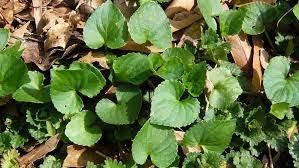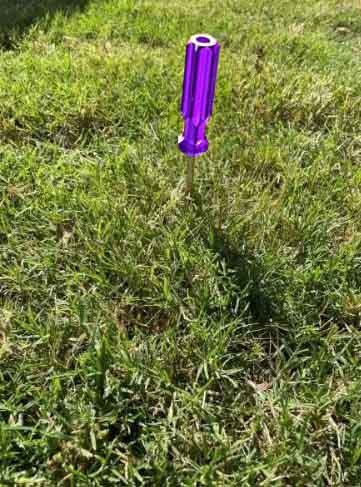Let us green up your lawn this year!
Wild Violets in Your Lawn:
A Homeowner’s Guide to Identification and Control

Wild violets may look charming with their delicate purple flowers, but these persistent weeds can quickly take over your lawn if left unchecked. If you're struggling with wild violets in your grass, you’re not alone. Let’s explore why they appear, how they spread, and the best ways to eliminate and prevent them from invading your lawn.
Need Help?
We understand that not everyone prefers to DIY their lawn. Feel free to reach out to us for advice or a free lawn weed control quote.

How to Identify Wild Violets
• Leaves: They have heart-shaped, glossy green leaves with scalloped edges.
• Flowers: Their blooms are typically purple or blue, with five petals, though some may appear white or yellow.
• Growth Habit: Wild violets grow low to the ground in dense clusters, forming thick patches in lawns.
• Roots: They have a deep, fibrous root system with rhizomes that make them difficult to remove.
• Bloom Time: They flower in early spring and may continue sporadically throughout summer.
Why Do I Have Wild Violets in My Lawn?
Wild violets thrive in lawns with the following conditions:
• Shady Areas: These weeds prefer moist, shaded lawns where grass struggles to compete.
• Compacted Soil: If your soil is dense and compacted, it creates the perfect environment for wild violets to establish roots. They are particularly common in Georgia lawns with clay-based or compacted soils.
• Low-Maintenance Lawns: Lawns that are not regularly fertilized or aerated tend to have more wild violets since weak grass allows them to take over. Once you get them, they are very difficult to kill.
• Grass Type: Wild violets thrive in cool-season grasses like Fescue grass and even garden beds.
Wild violets spread through two primary methods:
• Rhizomes (Underground Stems): These plants have aggressive root systems that allow them to multiply underground, making them difficult to remove manually.
• Self-Seeding: Wild violets produce seeds in both their visible flowers and hidden self-pollinating flowers, allowing them to spread rapidly.
Growth Patterns of Wild Violets
• Wild violets typically emerge in early spring and continue growing throughout the warmer months.
• Their heart-shaped leaves form dense patches, choking out grass and desirable plants.
• During fall, they produce underground flowers that go unnoticed but generate seeds for the following season.

How Do I Kill Wild Violets in My Lawn?
Eliminating wild violets in your lawn requires persistence and a combination of techniques:
• Selective Herbicides: Use a broadleaf herbicide containing triclopyr or dicamba, which specifically targets wild violets without harming your grass. Just make sure to read the label for the herbicide in order to know which products are safe for your grass and when to apply them.
• Repeated Applications: The key is consistancy and timing. One treatment won’t be enough and it can take a few years to get completely under control. Make sure to apply a couple coats of herbicides in the fall when the plant needs to build it's fod storage for winter. Then apply a couple more coats in the spring when the wild violets are comming out of dormancy again. You will need to spray the wild violet each time it starts to recover during the summer in order to kill it.
• Hand-Pulling: For small infestations, dig up wild violets by the root. Be sure to remove the entire rhizome system to prevent regrowth. Then patch in new dirt and grass plugs.
• Aeration & Overseeding: Strengthen your lawn by aerating compacted soil and overseeding with thick turfgrass to compete with wild violets.

How Can I Prevent Wild Violets in My Lawn?
• Apply Pre-Emergent Herbicides: Prevent new wild violet seeds from germinating by applying a pre-emergent weed control treatment in early spring.
• Fertilize Properly: Apply a balanced lawn fertilizer to keep your turf thick and vigorous.
• Mow at the Proper Height: Taller grass provides shade and discourages violet growth.
• Water Deeply but Infrequently: This promotes deep grass roots, making it harder for wild violets to establish. to compete with wild violets.
Why Trust Absolute Green Landscaping?
At Absolute Green Landscaping, we are licensed by the Georgia Department of Agriculture and have over 16 years of experience in weed control and lawn fertilization services. We specialize in helping homeowners in Buford, GA, and surrounding areas eliminate wild violets and maintain lush, green lawns.
📞 Need help getting rid of wild violets? Contact Absolute Green Landscaping for expert lawn weed control solutions today!
Why Choose Absolute Green Landscaping?


At Absolute Green Landscaping, we provide expert lawn aeration in Buford, GA and surrounding areas. With over 16 years of experience, our team knows exactly how to tackle Georgia’s tough clay soil. Our process is efficient, professional, and guaranteed to give your lawn the boost it needs.
📞 Get a Free Lawn Aeration Quote Today!
Don’t let compacted soil ruin your lawn’s potential! Contact Absolute Green Landscaping today for a free lawn aeration quote. Let’s make your lawn the envy of the neighborhood!









